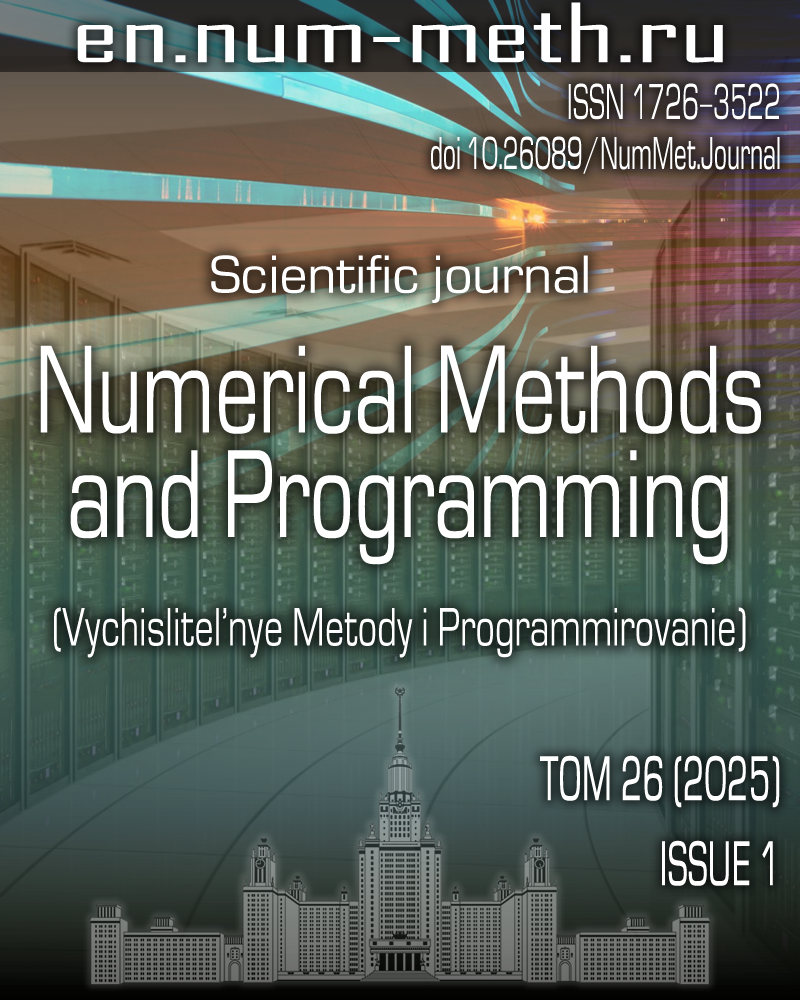DOI: https://doi.org/10.26089/NumMet.v26r106
Mathematical modeling of impedance for a perfect electric conductors system with lumped elements in a homogeneous medium using the augmented electric field integral equation
Keywords:
Abstract
The solution of Maxwell’s equations for perfect electric conductors in a homogeneous medium is considered using an augmented electric field integral equation (A-EFIE). The resulting system of equations is discretized using the Galerkin method. The method for constructing a numerical scheme is presented, which allows calculating the impedance of a printed circuit board power system together with the lumped electrical components placed on it. Additionally, boundary conditions typical for microelectronic devices are considered. The system of linear equations obtained through discretization is solved iteratively, with the fast multipole method used to accelerate the matrix-vector product. The methodology was verified using the example of scattering of a monochromatic wave by a sphere, for which an analytical solution exists, as well as through the impedance modeling of a printed circuit board, where the results were compared with those obtained from commercial software.
Published
Issue
Section
References
- J.-M. Jin, The Finite Element Method in Electromagnetics(Wiley, New York, 2014).
- W. C. Gibson, The Method of Moments in Electromagnetics(CRC Press, New York, 2021).
doi 10.1201/9780429355509 - R. F. Harrington, Field Computation by Moment Methods(Wiley-IEEE Press, New York, 1993).
- L. J. Jiang and W. C. Chew, “A Mixed-Form Fast Multipole Algorithm,” IEEE Trans. Antennas Propag. 53 (12), 4145-4156 (2005).
doi 10.1109/TAP.2005.859915 - Ö. Ergül (Ed.), New Trends in Computational Electromagnetics (SciTech Publ., London, 2019).
doi 10.1049/SBEW533E - A. V. Setukha and S. N. Fetisov, “Peculiarities of the Boundary Integral Equation Method in the Problem of Electromagnetic Wave Scattering on Ideally Conducting Bodies of Small Thickness,” Numerical Methods and Programming 17 (4), 460-473 (2016).
doi 10.26089/NumMet.v17r443 - D. V. Klyukin, D. M. Mochalov, and S. P. Kuksenko, “On Techniques to Compute Surface Singular Integrals for Formulating the Matrix-Vector Equation of the Moment Method When Solving Antenna Problems,” Proceedings of TUSUR University 27 (1), 23-34 (2024).
doi 10.21293/1818-0442-2024-27-1-23-34 - S. A. Sivak, Development of Algorithms for Numerical Solution of Electromagnetism Problems Using Scalar and Vector Boundary ElementsPhD Thesis in Physics and Mathematics (Novosibirsk State Technical University, Novosibirsk, 2017).
- Z. G. Qian and W. C. Chew, “An Augmented Electric Field Integral Equation for High-Speed Interconnect Analysis,” Microw. Opt. Technol. Lett. 50 (10), 2658-2662 (2008).
doi 10.1002/mop.23736 - T. Xia, H. Gan, M. Wei, et al., “An Integral Equation Modeling of Lossy Conductors with the Enhanced Augmented Electric Field Integral Equation,” IEEE Trans. Antennas Propag. 65 (8), 4181-4190 (2017).
doi 10.1109/TAP.2017.2718587 - Y. Wang, D. Gope, V. Jandhyala, and C.-J. R. Shi, “Generalized Kirchoff’s Current and Voltage Law Formulation for Coupled Circuit-Electromagnetic Simulation with Surface Integral Equations,” IEEE Trans. Microw. Theory Tech. 52 (7), 1673-1682 (2004).
doi 10.1109/TMTT.2004.830482 - J.-M. Jin, Theory and Computation of Electromagnetic Fields(Wiley, Hoboken, 2010).
doi 10.1002/9780470874257 - D. J. Griffiths, Introduction to Electrodynamics(Cambridge University Press, Cambridge, 2023).
doi 10.1017/9781009397735 - M. Taskinen and P. Yla-Oijala, “Current and Charge Integral Equation Formulation,” IEEE Trans. Antennas Propag. 54 (1), 58-67 (2006).
doi 10.1109/TAP.2005.861580 - S. Rao, D. Wilton, and A. Glisson, “Electromagnetic Scattering by Surfaces of Arbitrary Shape,” IEEE Trans. on Antennas Propag. 30 (3), 409-418 (1982).
doi 10.1109/TAP.1982.1142818 - K. F. A. Hussein, “Accurate Representation of Excitation and Loading for Arbitrarily Shaped Antennas Composed of Conducting Surfaces in the Method of Moments,” Prog. Electromagn. Res. B 36, 151-171 (2012).
doi 10.2528/PIERB11100709 - P. J. Pupalaikis, S-Parameters for Signal Integrity(Cambridge University Press, Cambridge, 2020).
doi 10.1017/9781108784863 - Y. Saad, Iterative Methods for Sparse Linear Systems(SIAM, Philadelphia, 2003; Mosk. Gos. Univ., Moscow, 2013).
doi 10.1137/1.9780898718003 - Ö. Ergül and L. Gürel, The Multilevel Fast Multipole Algorithm (MLFMA) for Solving Large-Scale Computational Electromagnetics Problems(Wiley-IEEE, Chichester, 2014).
doi 10.1002/9781118844977 - N. A. Gumerov and R. Duraiswami, Fast Multipole Methods for the Helmholtz Equation in Three Dimensions(Elsevier, Oxford, 2004).
doi 10.1016/B978-0-08-044371-3.X5000-5 - C. A. Balanis (Ed.), Modern Antenna Handbook(Wiley, New York, 2007).
doi 10.1002/9780470294154 - G. Mie, “Beitr854ge zur Optik trüber Medien, speziell kolloidaler Metallösungen,” Annalen der Physik 330 (3), 377-445 (1908).
doi 10.1002/andp.19083300302
License
Copyright (c) 2025 В. М. Аушев, В. О. Милицин

This work is licensed under a Creative Commons Attribution 4.0 International License.


